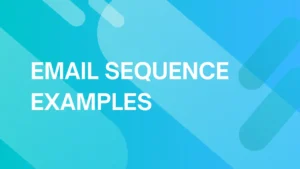
What is an Email Delivery Rate (and How to Improve It)
Emails are a cornerstone of digital marketing, acting as a direct line of communication between businesses and their audience.
But, one question looms large for marketers: How many of these emails actually reach the intended inbox?
That’s where the concept of email delivery rate comes into play.
The email delivery rate is a key performance indicator that can significantly influence your marketing campaigns.
But fear not, understanding and improving it is not as challenging as it may seem.
No matter if you’re new to email marketing, or looking to refine your existing strategy, this guide will tell you everything you need to know about email delivery rates.
What is Email Delivery Rate?
Email delivery rate is a metric that represents the percentage of sent emails that were accepted by the recipient’s servers without bouncing.
In essence, it’s a measure of the effectiveness of your email campaigns in terms of their reach.
Email Delivery Rate vs. Email Deliverability
While the terms “delivery rate” and “email deliverability” might seem interchangeable, they serve different roles in the context of email marketing.
- Delivery Rate: This is a straightforward metric, calculated as the number of emails delivered divided by the number of emails sent, multiplied by 100. It gives you a numerical value, usually in the form of a percentage, indicating the success of your email reaching the inbox.
- Email Deliverability: On the other hand, email deliverability is a broader concept that involves various factors affecting whether your email will land in the inbox, spam folder, or somewhere else altogether. It encompasses issues like sender reputation, email content quality, and subscriber engagement.
Knowing the difference between these two is important for any marketer or business aiming to maximize the impact of their email campaigns, and both metrics are essential for a successful campaign.
It’s important to note a couple of things about email delivery rates and email deliverability before moving on:
- A good email delivery rate on its own does not mean that your messages have landed in the recipients’ primary inboxes.
- A good email deliverability rate on its own doesn’t indicate that all of your emails have gotten to the actual recipients.
Both metrics need to be examined together to get a full overview of how successful your campaign is.
How to Calculate the Email Delivery Rate?
Calculating your email delivery rate is a simple, straightforward process, and it’s crucial for evaluating the effectiveness of your email campaigns.
Here is a simple formula on how to calculator the email delivery rate:
| Email Delivery Rate = (Number of Emails Delivered / Number of Emails Sent) x 100 |
So, for example, if you sent out 1,000 emails and 950 of those were successfully delivered, your email delivery rate would be:
| Email Delivery Rate = (950 / 1000) x 100 = 95% |
A 95% delivery rate is generally considered excellent, meaning that the vast majority of your emails are reaching their intended recipients.
What Impacts Email Delivery Rates?
a) Hard Bounces
Managing hard bounces is critical for successful email delivery.
These occur when an email cannot be delivered due to a permanent issue like an invalid email address
As you start to notice them, it’s important to remove these addresses from your list immediately to maintain a good sender reputation.
b) Soft Bounces
Soft bounces are temporary delivery failures, often due to a recipient’s full inbox or a temporarily unavailable server.
While you can do little about these, they should be monitored because repeated soft bounces can turn into hard bounces.
c) Email List Health
Email marketing databases naturally degrade by about 22.5% yearly.
Poor list hygiene, like using outdated or purchased lists, can result in higher bounce rates and lower delivery rates.
Maintain a clean and engaged list to improve your email deliverability.
d) ISPs, ESPs, and MTAs
Your mail transfer agent (MTA) interacts with Internet Service Providers and Email Service Providers during the delivery process.
A reputable MTA will temporarily block suspicious emails, affecting the delivery time.
Additionally, ISPs and ESPs have their own filtering algorithms that may label your email as spam based on various factors, including the content and the sender’s reputation.
e) Hardware Errors
Hardware limitations can negatively affect your email delivery rate. For instance, if your server runs out of network bandwidth or storage, emails may be delayed or not sent at all.
Insufficient memory can also slow down the email-sending process.
Addressing these hardware issues promptly can help maintain a steady email delivery rate.
f) IP Reputation
The reputation of your IP address plays a crucial role.
If you’re associated with spam or other malicious activities, your IP may be blacklisted, severely affecting your email delivery rates.
Each of these elements can influence whether your email gets to its intended recipient or ends up filtered out, either temporarily or permanently.
What Is Considered as a Good Email Delivery Rate?
So, what makes a good email delivery rate?
While there’s no one-size-fits-all answer, industry standards suggest that an email delivery rate between 89% and 95% is considered good.
Bounce rates, which affect email delivery, should ideally sit around 0.3% or less, no matter what industry you’re in.
Anything below 90% should be a red flag, signaling that it’s time to investigate and resolve issues that might be affecting your email delivery.
High delivery rates indicate that your emails are not only being sent but are also successfully reaching your audience.
This is a key element in your email marketing strategy, as emails that don’t reach the inbox have zero chance of getting opened, let alone converting!
Maintaining a high rate assures that you’re not wasting resources on emails that never see the light of day.
With a strong delivery rate, you can focus on sending compelling content that resonates with your audience, ultimately driving interaction and bolstering customer awareness.
Before delving into improving your email delivery rates, it’s essential to consider the role of email prospecting in expanding your marketing reach.
Email prospecting involves actively seeking out and adding new contacts to your email lists who have shown interest in your industry or products.
This proactive approach not only broadens your audience but also enhances the relevance of your campaigns, paving the way for improved delivery rates and engagement.
How to Improve Email Deliverability and Delivery Rate?
Improving your email deliverability and delivery rate is essential for maximizing the impact of your email marketing campaigns.
High rates ensure that your message gets to the inbox, where it has the chance to be opened and acted upon.
Here are key steps to improve both deliverability and delivery rates.
1. Authenticate Your Account
Email authentication is a key component of your deliverability strategy.
It verifies that your emails are coming from a legitimate source, making ISPs more likely to deliver your messages to the inbox rather than the spam folder.
Common authentication methods include SPF, DKIM, and DMARC protocols.
When properly used, these protocols can significantly reduce the chances of your emails being flagged as spam or phishing attempts.
2. Improve Your Reputation
Your sender reputation is a crucial factor in determining whether your emails hit the inbox or the spam folder.
One way to improve your reputation is through IP warming, a technique that gradually increases your sending volume to build trust with ISPs.
Warmup Inbox can significantly aid in IP and domain warming.
This easy-to-use tool builds your IP address and domain reputation, improving your email deliverability over time.
Warmup Inbox also provides analytics, offering insights into your campaign performance.
| Want to start making your IP a trusted source in the eyes of the spam filters? Sign up for free! |
3. Keep Your Email Lists Clean
For maintaining high engagement rates and a positive sender reputation, you’ll need a clean email list.
Regularly remove inactive or non-responsive email addresses from your list before any new campaigns.
A cleaner list can lead to higher open rates, click-through rates, and ultimately, conversion rates.
For an immaculate email list, consider using EmailListVerify.
This tool removes invalid addresses, hard bounces, and spam traps that can tarnish your sender’s reputation.
The software integrates seamlessly with other email marketing platforms for effortless list validation.
| Need to tidy up your email list? Sign up with EmailListVerify and validate 100 emails at no cost! |
4. Have a Dedicated IP Address & Reputable ESP
Using a dedicated IP address is an essential move for anyone serious about improving email deliverability and delivery rates.
Unlike a shared IP address, where your email-sending reputation can be affected by other users, a dedicated IP gives you full control.
This setup allows for consistent sending behavior, making it easier for internet service providers (ISPs) to assess your sending reputation.
Over time, a dedicated IP can build a positive sending reputation, ensuring your emails land right where they’re supposed to, in your subscriber’s inbox.
Additionally, partnering with a reputable email service provider (ESP) can further bolster the effectiveness of your email campaigns.
A well-known ESP provides a solid infrastructure for sending emails, as well as features like tracking, analytics, and customer support to aid in your email marketing strategy.
5. Avoid Spam Traps
Dodging spam traps and honeypots in your email journey can feel a lot like trying to tiptoe around landmines.
Spam traps, in simple terms, are email addresses created by ISPs or anti-spam organizations designed to catch spammers or marketers who aren’t managing their email lists properly.
When you land in a spam trap, it’s a red flag for ISPs, which is quite harmful to your sender reputation, thus hurting your delivery rate and deliverability.
Email scraping tools can help gather email addresses, but ensure these addresses are verified to avoid spam traps.
How can you avoid spam traps?
Here are a few practices that can help keep your emails safe:
- Have a clean email list: As stated above, keeping a clean email list is helpful in staying clear of spam traps.
- Use double opt-in: Spam traps can’t confirm themselves, so having your readers confirm that they’ve subscribed to your emails lets you know that they’re the real deal.
- Never purchase email lists: While tempting, purchasing email lists is a surefire way to land yourself in spam traps, as whoever curated the list isn’t likely to be validating the emails on it.
6. Optimize Your Emails
Creating emails that resonate with your audience can drastically improve your engagement metrics, including open and click-through rates.
Optimization goes beyond writing engaging emails, it encompasses the layout, design, and even the timing of your emails.
- Mobile-friendly design: With a significant portion of users accessing emails via mobile devices, ensuring your emails are mobile-friendly is no longer optional. Use responsive design to make your emails look good on any device.
- Personalization: Personalized emails often yield higher engagement rates. Studies show that brands that personalize promotional marketing emails experience 27% higher unique click rates and 11% higher open rates than those that do not personalize. That’s a lot! So, use the recipient’s name and customize the content based on their past behavior or preferences to give yourself an extra boost.
- Clear Call-to-Action (CTA): Guide your recipients on what action to take by using an explicit, eye-catching CTA. Whether it’s making a purchase, signing up for a webinar, or sharing your content, a clear CTA can drive action and engagement.
- Timing matters: Your emails have a higher chance of getting opened if sent at a time when your audience is most likely to be checking their inbox. There is no golden rule for the best time to send emails, but WFLA states that between 10 AM and 2 PM on Tuesday, Wednesday, or Thursday is a good window.
7. Test and Track Your Emails
How can you improve if you’re not looking at the results of your hard work?
Keep an eye on key metrics like open rates, click-through rates, and bounce rates to gauge the effectiveness of your campaign.
A/B testing of subject lines, content, and sending times can offer more valuable information you can use for further optimization.
8. Learn how to send an email to multiple recipients individually
When sending emails to multiple recipients, it’s crucial to ensure each email is personalized and sent individually.
This practice can significantly improve engagement rates and prevent your emails from being marked as spam. By addressing each recipient individually, you can maintain a higher level of personalization and relevance.
Did you know that Warmup Inbox also features an email spam tester?
This handy feature allows you to check the spam score of your emails before hitting the send button.
Using the free spam tester lessens the likelihood of your emails being flagged, ensuring higher deliverability and engagement rates!

Summary
Improving your email deliverability and delivery rate is an ongoing process that involves multiple facets, from authenticating your account to optimizing your emails for better engagement.
With the right set of tools, like Warmup Inbox for email warmup and EmailListVerify for email list cleaning, you can significantly boost your campaign’s performance and achieve your marketing objectives.



